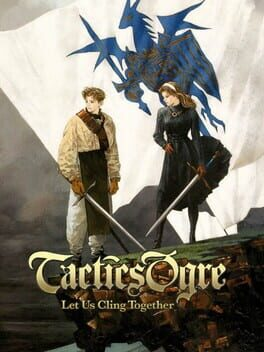subdirectory_arrow_right Tactics Ogre: Let Us Cling Together (Game), Ogre Battle: The March of the Black Queen (Game), Ogre Battle (Collection)
▲
2
▼
The series takes several naming cues from the English glam rock band Queen, who are highly popular in Japan. The name of the series itself, Ogre Battle, comes from a song off of Queen's 1974 sophomore album Queen II; another song on the album, "The March of the Black Queen", is the namesake for the series' first installment. The second game, Tactics Ogre: Let Us Cling Together, takes its name from Queen's 1976 song "Teo Torriatte (Let Us Cling Together)", an homage to their Japanese fanbase.
Another Queen reference in The March of the Black Queen can be found with one of its regions, the Rhyan Sea. The area's name comes from "Seven Seas of Rhye", a song which appears in an unfinished instrumental form on Queen's 1973 self-titled debut and was later completed with vocals on Queen II.
Another Queen reference in The March of the Black Queen can be found with one of its regions, the Rhyan Sea. The area's name comes from "Seven Seas of Rhye", a song which appears in an unfinished instrumental form on Queen's 1973 self-titled debut and was later completed with vocals on Queen II.
▲
1
▼
In a 1995 interview with the game's director Yasumi Matsuno, found within the Dengeki SFC magazine, he clarified that the game was a part of the Ogre Battle series, but it was not a direct sequel to Ogre Battle: The March of the Black Queen. The games' world and environments are shared, but the gameplay systems are completely dissimilar. When asked why the gameplay system was changed, he responded:
"First off, after we finished the Ogre Battle development, we determined that doing another 3D real-time simulation game for the Super Famicom was going to be difficult. There is a special chip now for the SFC that offers more possibilities, but it’s also very expensive to use [this could be referring to the Super FX chip]. Therefore, we abandoned the idea of doing another, powered-up version of Ogre Battle, and instead decided to develop a brand new system."
"Another reason was that we actually started the planning for Tactics Ogre three months before the release of Ogre Battle. To decide on a direct sequel then would have been pointless if Ogre Battle didn’t sell well, and we didn’t have any confidence that it would. Ultimately it was very popular, so we carried over just the world and setting."
"Also, in Ogre Battle the units moved in real-time, which meant you couldn’t take your time and plan out a strategy. For us, this was a big point we wanted to improve on. From the beginning of the Tactics Ogre development, therefore, we never saw real-time as an option."
"First off, after we finished the Ogre Battle development, we determined that doing another 3D real-time simulation game for the Super Famicom was going to be difficult. There is a special chip now for the SFC that offers more possibilities, but it’s also very expensive to use [this could be referring to the Super FX chip]. Therefore, we abandoned the idea of doing another, powered-up version of Ogre Battle, and instead decided to develop a brand new system."
"Another reason was that we actually started the planning for Tactics Ogre three months before the release of Ogre Battle. To decide on a direct sequel then would have been pointless if Ogre Battle didn’t sell well, and we didn’t have any confidence that it would. Ultimately it was very popular, so we carried over just the world and setting."
"Also, in Ogre Battle the units moved in real-time, which meant you couldn’t take your time and plan out a strategy. For us, this was a big point we wanted to improve on. From the beginning of the Tactics Ogre development, therefore, we never saw real-time as an option."
▲
1
▼
According to game's director Yasumi Matsuno in a 1995 Dengeki SFC magazine interview, it took the developers two and a half years (including several delays) to make the game, and by the end expressed that he was extremely tired from its development.
Related Games
Tactics Ogre: Let Us Cling Together
Ogre Battle 64: Person of Lordly Caliber
Ogre Battle: The March of the Black Queen
Snowboard Kids
PowerWash Simulator
Persona 3 Portable
Call of Duty: Black Ops II
Persona 3 FES
Shin Megami Tensei: Devil Summoner - Soul Hackers
Nanashi no Game
Persona 4 Revival
Just Cause 3
The 3rd Birthday
Catherine: Full Body
Shin Megami Tensei: Nocturne
Kingdom Hearts HD 2.5 Remix
Polarium Advance
Tomb Raider
Etrian Mystery Dungeon
Lightning Returns: Final Fantasy XIII
Final Fantasy VII
Game of Thrones
Skylanders: Spyro's Adventure
The Quiet Man
Gouketsuji Ichizoku Matsuri Senzo Kuyou
Catherine
SinoAlice
Balan Wonderworld
Dragon Quest Heroes: Rocket Slime
Life is Strange: Double Exposure
Deus Ex: Human Revolution
Etrian Odyssey
Hitman: Absolution
Final Fantasy X-2
Wacky Races
Marvel's Guardians of the Galaxy
Shin Megami Tensei Devil Summoner: Raidou Kuzunoha vs. The Soulless Army
Final Fantasy I & II: Dawn of Souls
American Mensa Academy
Stranger of Paradise: Final Fantasy Origin
Final Fantasy XIII-2
Persona 2: Eternal Punishment
Odin Sphere
Digital Devil Story: Megami Tensei
Final Fantasy: Mystic Quest
Mobius Final Fantasy
Crusader of Centy
Call of Duty: Advanced Warfare
Persona 4
Diablo III
